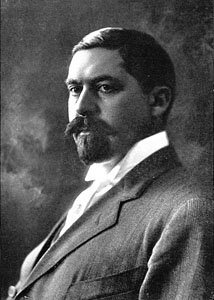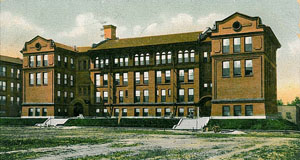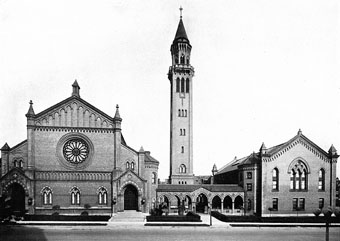Edward Gordon Garden, FAIA (1871-1924)
 |
| Edward Gordon Garden circa 1910 |
Hugh and Frank (another brother about whom virtually nothing is known except that he was a practicing architect) Garden remained in Chicago; Hugh worked as a free-lance designer for an assortment of architects including Richard E. Schmidt, Frank Lloyd Wright and Louis Sullivan. In 1894, Edward (Ned) Garden came to Shepley, Rutan & Coolidge's St. Louis office, joining John Lawrence Mauran who had been sent from the firm's Chicago office to St. Louis the year before.
The first mention of Ned Garden's name in St. Louis architectural circles is contained in a report about the July 1894 meeting where local draftsmen disbanded their "Base Ball Society" and formed the more professional-sounding St. Louis Architectural Sketch Club. Garden was elected president of the new organization in 1895 but left St. Louis the following year, not to return until 1899.
His perspective drawing of that year for Shepley, Rutan & Coolidge's (with John Lawrence Mauran) winning design for the Saint Louis Trust Company Building (northwest corner of 4th and Locust--now razed) clearly establishes Garden as a talent to be mentioned in the same breath as Harvey Ellis and Oscar Enders. (Shepley, Rutan & Coolidge's St. Louis office beat Eames & Young and Theodore Link for the Trust Company commission.)
 |
| Smith Academy & Manual Training School |
The firm was not among those included on the Board of Architects for the St. Louis World's Fair and thus designed only small buildings for that occasion. More lasting, however, was their 1903 design for the First Church of Christ Scientist on Kingshighway at Westminster - the first in a remarkable series of institutional commissions: 1905--the former Smith Academy and adjacent Manual Training School for Washington University (just west of Union Boulevard and north of Delmar); 1906 - the Cabanne Branch Library at Union and Cabanne; 1906 - Pilgrim Congregational Church at Union and Kensington; 1906 - Second Baptist Church on Kingshighway between Washington and McPherson; 1906 - the Racquet Club on Kingshighway; and the 1907 former Unitarian Church of the Messiah at Union and Enright. With the exception of the Church of the Messiah (for which design should be attributed to Mauran, a member of the congregation) and the Cabanne Branch Library, most of the commissions show Garden's growing influence in the design process.
 |
| Second Baptist Church |
In addition to the works listed above, the young firm also received important commissions for mercantile buildings (including the 1902 building for Carleton Dry Goods which stood at the northeast corner of Washington and 12th), for the first new department store in the city (the Grand Leader - Stix, Baer & Fuller from 1905), out-state libraries and numerous houses including such private street commissions as #12 Portland Place (1905) and #19 Washington Terrace (1907). The Washington Terrace house is the most interesting in any discussion of Garden's role with the firm; although larger, it clearly was the model for his own 1908 house on Windemere Place which was built three years after his marriage to Edith Banta Webb from Chicago. The 1909 house at #34 Westmoreland for George F. Steedman, patron of the room which bears his name at the Public Library, is usually attributed to Mauran, Russell & Garden. Garden, however, left the firm in 1909 to establish his own office. The Steedman house should probably be credited to Garden alone. A story about the 1910 Christmas Minstrels show at the new clubhouse (514 Culver Way - demolished) of the St. Louis Architectural Club included the following:
Among the guests were noticed many of the old-time club members who, in the early days of the club, stood by it and did the hard work and the hard playing. Among these were Oscar Enders and Ned Garden. Both expressed themselves as highly pleased with the new club quarters and intend visiting them again.
For reasons unknown to this writer, Garden and his family left for San Francisco in the fall of 1911. A personal note from Garden on the back of a card announcing the opening of his office in San Francisco's Phelan Building stated: "I have my office going and am working nights and Sundays!" According to what information is available in St. Louis, Garden stayed in California until 1922, then moved to Cleveland, Ohio where he died in February of 1924.
